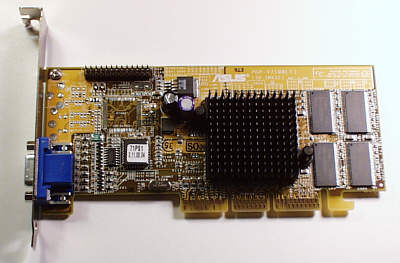
The GeForce-2 MX cards have
arrived!! We've had them for about two weeks
now, and have had some time to give them a workout. The results? I
think NVidia has done a great job on making the GeForce-2 chip affordable
for folks on just about any budget. It's a brilliant idea, and I'm
sure they are going to get the lions share of lower-end video card sales. Other
web sites just reviewed the 32MB model, but we got a hold of a 16MB V7100
as well, to see how it compared.
Introduction:
As most of you probably know, the GeForce-2 MX cards are based
on the chip that powers the fastest video cards on the market, the NVidia
GeForce-2 GTS chip. The board design on the MX cards is scaled back,
and the memory is of the slower SDRAM type, rather than more expensive,
faster DDR memory. The result is that the memory speed represents
the main bottleneck for 3D performance. And yet, these little cards
can hold their own against GeForce-1 DDR video cards at lower resolutions. In addition, the
graphics core is clocked slower, and has a simple heat sink, instead of
the heat sink and fan found on other GeForce cards. The result is a
low-cost, high speed 3D accelerator that can still be overclocked.
What do you get in the box? You get
the card, a nice 60 page manual, the driver CD, DVD playback software, a
game color correction utility called 3Deep,and one full bundled game;
Soldier of Fortune. Most low-cost video cards don't have bundled
games, so the addition of SOF is quite a nice for a very low-cost
card. I also greatly appreciate the inclusion of DVD software in the
box.
Asus V7100 models:
The MX cards come in two basic flavors: the
32MB model, and for those on a really tight budget, there is a 16MB
version. The 16MB MX cards will run you around $120, which is a very nice
price. But the 16MB model does not do well at higher resolutions, as
you might expect. Let's take a look at how they stack up against
each other.
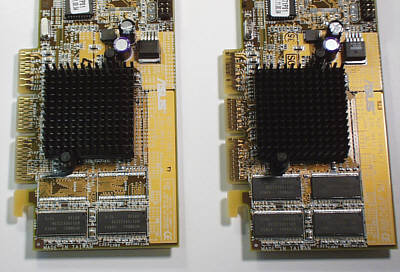
The 32MB model of the Asus V7100 is shown at the
right of the
picture, while the 16MB V7100 is shown at the left. The models we
reviewed were the ones without TV out capability. One of the TV-out
versions features "Twin-View", which give you the ability to view
2 screens at once. So, for example, you could watch a DVD movie on
your TV screen while working in Windows on your monitor! But the
so-called "Pure" models I reviewed don't have the TV out or
Twin-View. If you want the TV out function, you need the V7100-T model.
The MX boards are relatively simple looking video
cards, especially if you compare them with Voodoo5 5500 cards. They
have a simple heat sink on the graphics core chip, and a bare minimum of
components on the board. The only physical difference between the
16MB and 32MB models is the lack of two memory chips on the 16MB version.
Comparisons:
How does the 16MB version compare with the 32MB model? The graph
below if from a quick test of Direct 3D performance with the 2 cards in an
800MHz Athlon (T-Bird), running on an Asus A7V motherboard with 128MB of
PC-133 SDRAM.
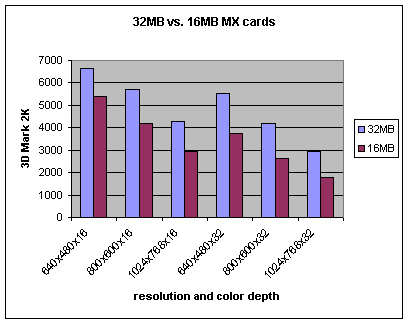
As you can see, the 16MB model does quite
well at low resolutions and in 16 bit color. However, the 16MB card
runs between 20% and 40% slower than the 32MB model at the same
resolutions. For most people, the extra $30 for the 32MB model will
be well worth it.
But now for the major weakness of the MX cards: memory
bandwidth. If we throw a 32MB Hercules 3D Prophet GeForce-1 DDR
(double-data rate memory) card into the graph, you can see the problem.
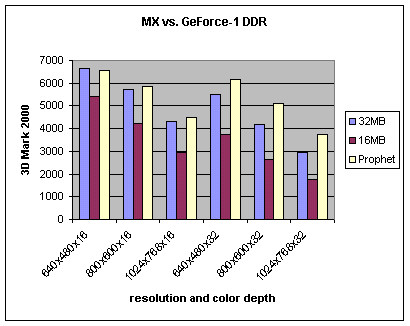
The 32MB MX card actually beats the 3D Prophet slightly at the
lowest resolution, but as the memory bandwidth is strained at higher
resolutions and color depths, the MX cards begin to fall substantially
behind. At all 32-bit resolutions, the older GeForce DDR card beats
both GeForce MX cards by a good margin.
Test Setups: I
tested the 32MB V7100 'Pure' MX card in several systems to give you an idea
of how it would perform at different speeds. Rather than using the new
Detonator-3 drivers, which seem to have a few bugs, I stuck with the tried
and true Detonator-2 version 5.30 drivers. I was not that interested
in antialiasing this time around, so I really didn't need the Detonator-3
drivers (6.18).
I tested the 32MB V7100 on a Pentium III 550E
running first at 550MHz (100MHz bus) and then at 825MHz (150MHz bus
setting). That setup included an Abit VT6X4 motherboard and Asus FC-PGA to
slot-1 adapter as well as 128MB of PC-133 SDRAM. I also tested the cards
on an Asus A7V with both a Athlon 800 (T-Bird) and Duron 650.
D3D in Different Setups:
The chart below shows how the 32MB MX card works in 3 different test
setups: Pentium III 550MHz, Pentium III 825MHz and Athlon 800MHz.
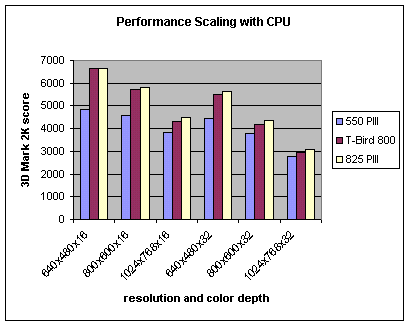
As you can see, at higher resolutions and color depths, the
card's fill rate is the limiting factor, so that CPU speed has little
effect on performance. Therefore, regardless of system speed, the performance of the MX cards is
not good at higher resolutions and color depths.
Economy System:
At this point, I wanted to see if the 16MB V7100 had
enough horsepower to run current 3D games with high detail in a Duron system.
For this I decided on a Duron 650. I compared 3D Mark 2000 and Quake
III Arena scores at the default speed, and with the MX card and system
overclocked. The next graph shows the base 3D Mark 2K scores, and
the performance improvement you can expect when overclocking. The second
set of bars show scores with the card's memory to overclocked to 210MHz,
while the final set is for the card's memory at 210MHz, and the system bus
running at 110MHz.
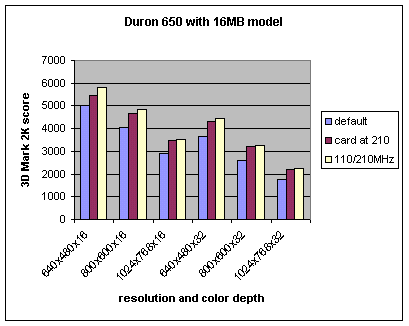
At 800x600x32, the 16MB V7100 is so limited
by memory bandwidth that increasing the system speed from 650MHz to 715MHz
(110MHz bus) had almost no effect on the score. The next graph shows
Quake III Arena scores (Demo001) on the same system, under the same
conditions.
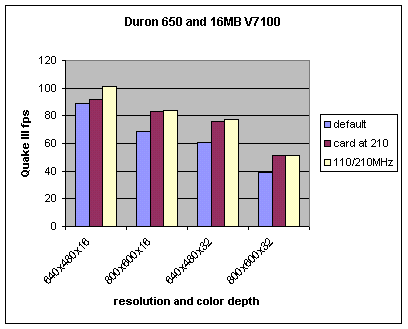
Again, the results indicate severe memory
bandwidth limitation. At higher resolutions and color depths, only
boosting the memory speed had any effect on frame rates.
Nonetheless, the scores at 800x600x16 are excellent, even without
overclocking. The tests were done with both geometric and texture
detail settings at maximum. So the answer to the question about
whether the 16MB card has enough horsepower is, yes. At modest
resolutions and color depths, a 16MB MX card will play current games at
very good frame rates, with maximum detail enabled, on a Duron 650MHz
system.
Overclocking:
The MX cards tend to run a bit hot, due to the lack of a cooling fan.
But it is a well known fact that
overclocking the graphics chip core on GeForce cards has little effect on
3D performance. This is because memory bandwidth is the
speed-limiting factor. That's why with GeForce cards, memory
overclocking is the most effective way of increasing performance.
The heat sink and thermal grease on MX cards
keep the graphics chip cool enough, but the heat sink does get quite warm to the touch during
operation. The heat sink is easy to remove if you want to replace it
with an improved cooler. Other reviews, such as the one at Anandtech.com,
complained that the heat sink was not attached securely enough. But many
overclockers will want to dispose of the heat sink in favor of something
with more guts. So the easy removal is a plus in my opinion.
Keep in mind that overclocking the core pf
the MX cards will not boost performance much, but increasing the memory
speed will. So I concentrated on increasing the memory speed with the
"Coolbits" utility in NVidia's driver set. The default
speeds of the MX cards are 175MHz on the graphics chip core, and 166MHz on
the SGRAM. Using Coolbits, I was actually able to run the memory at
the maximum setting available, which was 210MHz. The next graph shows how
the 32MB card scales in performance with memory overclocking.
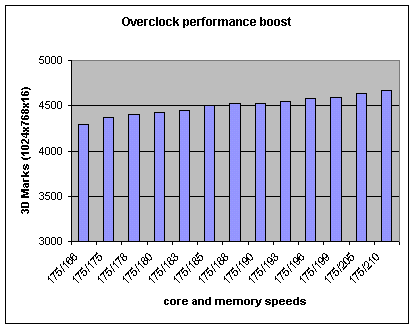
Obviously, NVidia was very conservative
with the default memory setting. But considering how hot the memory
got to the touch during benchmarking at 210MHz, it's clear that the cards
run the risk of overheating at this speed without additional
cooling. Either heat sinks attached to the memory chips with thermal
glue, or a strong fan directed at the memory chips would do. During the
tests I ran at 210MHz, I used an 80mm case fan positioned 1 inch from the
surface of the board. This kept both the heat sink on the graphics chip,
and the memory chips cool while running at this speed. The graph below
compares 3D Mark 2000 scores at memory speeds of 166MHz and 210MHz.

The performance boost is most noticeable at 800 x 600 with 32
bit color, giving a 13% increase in 3D Mark 2000 scores.
Quick Quake Benchmarks:
I of course used Quake3 Arena to test OpenGL performance.
The graph below shows how the V7100 32MB card handles Quake III in
the card's standard and overclocked conditions. The setup is the 800MHz
T-bird, running at default speed, with the 32MB V7100 card. I ran
both demo 001 and 002, at the default MX speeds (175/166MHz), and at the
highest overclocked level (175/210MHz).

At 800x600x32, overclocking the memory alone provided 14 to 16
fps better performance, meaning about a 21% to 23% increase in frame
rates! Not too shabby. Please remember to cool those memory chips if
you're going to run the memory continuously at 210MHz.
Best 3D Mark 2K Score:
One final test I wanted to conduct was to see what was the maximum 3D Mark
2K score I could get with the 32MB V7100 card. For this, I chose an
Athlon (T-Bird) 900MHz system running at 1008MHz (1.01GHz) on and Abit
KT7-RAID motherboard. With the memory chips on the V7100 overclocked
to 210MHz, the 3D Mark 2K score at 640x480x16 was a whopping 7325 3D
Marks!! That is a phenomenal performance score for a $150 video
card.
Summary:
As video cards go, you could simply say that the MX cards aren't as fast as
GeForce-2 GTS cards, but that would be missing the point. The
purpose of MX cards is to be fast and affordable, not just as fast
as possible. As such, I will not rate the MX cards lower because
they are not as fast as GTS cards. They were not meant to compete
with cards costing 3 times as much money. If you need the fastest
video card available, don't consider the MX cards. You'll want a
GeForce2 GTS card.
But if you are on a budget, or if you're
putting together a low-cost gaming system as a second (or third!) machine,
then MX cards such as the Asus V7100 should be just perfect. They
are almost as fast as GeForce-1 DDR cards, and they cost considerably
less. Overclocking the memory on the card will give you a nice additional speed
boost. Forget about using high resolutions and color depths
though. The memory bandwidth is too limiting for anything above
1024x768x16.
All things considered, the Asus V7100 cards
are in a price/performance range that no other video cards can
touch. The 16MB model is only for those on very tight budgets, since
the performance hit is just too high for a savings of only $30. It's
$30 well spent to go with the 32MB model. I can wholeheartedly
recommend the 32MB Asus V7100 for all gamers who don't want to spend too
much money. If you really need to save every penny, no other video card comes
close to the
16MB V7100's performance in that price range.
Pros:
- Very affordable
- Very good performance for the price
- Very overclockable memory
- Good Drivers
- Heat sink easy to replace with fan/heat sink
- Even comes with a great game!
|
Cons:
- Gets a little warm without a cooling
fan
- Not as fast at higher resolutions and
32-bit color
- 16MB model is, of course, slower
Price:
Approximately $150 US 32MB
$120 US 16MB
Rating:
4.6 out of 5
smiley faces (92%)
:) :) :) :) +
Availability:
16MB > Good, 32MB > Low
|
Copyright Sept. 20th, 2000 |